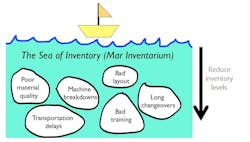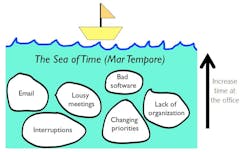Lean Office: Let's Get Serious About Lowering the Water Level
When it comes to the shop floor, every organization embracing lean uses Toyota’s rocks and lake metaphor to talk about improvement: You lower the water level (inventory) to reveal the rocks (obstacles) that prevent you from reaching the ultimate goal of 1x1 flow.
People constantly strive to remove inventory and other buffers that hide problems in the various production processes.
Now, consider what happens in the office. Since knowledge workers aren’t dealing with physical items as workers on the shop floor do, the resource they use as a buffer -- their version of inventory -- is time.
This makes no sense. If you’re going to preach the gospel of lean, everyone in the choir should be singing from the same page of the hymnbook—whether they’re wearing blue collars or white.
We often talk about office workers as though they deserve special treatment and different rules from shop floor workers. It’s true that their work is (often) more variable than the work on the production line. But this argument ignores the truth that they’re still production workers -- a different kind of production worker, but production workers nonetheless. And that means that we’re obligated to approach their work, and solve their problems, in the same way that we approach the work and the problems on the shop floor.
In Toyota Kata, Mike Rother argues that we should define target conditions for our processes. We probably won’t reach that target condition, but the attempt to solve the problems between our current state and the Promised Land will take us in the right direction.
Imagine what would happen if you set as a target condition something like, “Go home at 5 p.m.,” or “Only work 50 hours during the week.” There are countless obstacles to reaching that target, and the innumerable problems on the shop floor, with HR issues, with customers and suppliers, will almost certainly keep you from achieving that goal.
And yet.
And yet, if you actually defined that as a target condition, imagine how you would approach the waste that floods your day -- the meetings that start late with unprepared participants; the “reply-all” emails that everyone complains about; the torturous annual performance evaluations that don’t do a terribly good job of helping employees grow; the unnecessarily formal presentations you have to prepare on company-approved PowerPoint templates; the tracking and monitoring of vacation requests. You’d figure out ways to minimize or eliminate these low or no-value added activities rather than simply accepting them as an inevitable part of business life.
The lean mindset that is so valuable in improving the work on the shop floor is just as valuable (if not more so) in improving the work in the office. It’s time to start lowering the water level in the office, too.
About the Author
Dan Markovitz
President
Dan Markovitz is president of Markovitz Consulting, a firm that helps organizations become faster, stronger and more agile through the application of lean principles to knowledge work. He is a faculty member at the Lean Enterprise Institute and teaches at the Stanford University Continuing Studies Program. His book “Building the Fit Organization” has received the Shingo Research Award.



